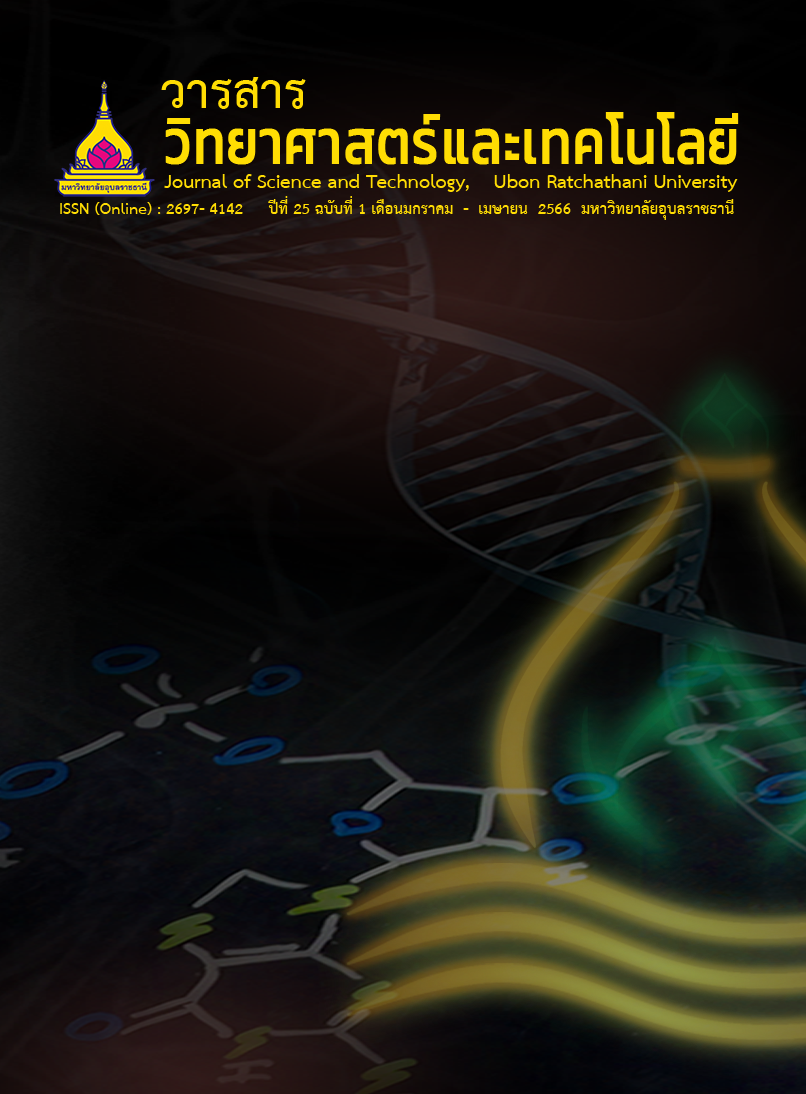ผลของสารสกัดกากกาแฟต่อการต้านอนุมูลอิสระ การยับยั้งการทำงานของแอลฟาอะไมเลสและไลเปส และการยับยั้งกระบวนการสร้างเซลล์ไขมัน
Main Article Content
บทคัดย่อ
กากกาแฟเป็นสารอินทรีย์เหลือทิ้งจากอุตสาหกรรมการแปรรูปกาแฟที่มีสารออกฤทธิ์ทางชีวภาพหลายชนิด งานวิจัยนี้มีวัตถุประสงค์เพื่อศึกษาผลของสารสกัดกากกาแฟต่อการต้านอนุมูลอิสระ การยับยั้งการทำงานของเอนไซม์แอลฟาอะไมเลส และเอนไซม์ไลเปส และการยับยั้งกระบวนการสร้างเซลล์ไขมัน เมื่อนำสารสกัดกากกาแฟที่สกัดด้วยเอทานอล ความเข้มข้น 70% มาวิเคราะห์ พบว่าสารสกัดกากกาแฟมีปริมาณฟีนอลิกรวมทั้งหมด และปริมาณฟลาโวนอยด์รวมทั้งหมด เท่ากับ 50.54 ± 0.08 มิลลิกรัมสมมูลของกรดแกลลิกต่อกรัมของสารสกัด และ 5.03 ± 0.15 มิลลิกรัมสมมูลของเควอร์ซิตินต่อกรัมของสารสกัด ตามลำดับ มีฤทธิ์ต้านอนุมูลอิสระ (IC50 = 171.18 ± 0.21 ไมโครกรัมต่อมิลลิลิตร) และมีฤทธิ์ยับยั้งการทำงานของเอนไซม์แอลฟาอะไมเลส (IC50 = 152.71 ± 0.37 ไมโครกรัมต่อมิลลิลิตร) และเอนไซม์ไลเปส (IC50 = 131.08 ± 1.94 ไมโครกรัมต่อมิลลิลิตร) นอกจากนี้ยังพบว่ามีฤทธิ์ยับยั้งกระบวนการสร้างเซลล์ไขมัน โดยการลดการสะสมไขมันใน pre-adipocyte ทำให้ไม่สามารถพัฒนาไปเป็นเซลล์ไขมันได้ การที่สารสกัดกากกาแฟมีฤทธิ์ต้านอนุมูลอิสระ ฤทธิ์ยับยั้งการทำงานของเอนไซม์แอลฟาอะไมเลส และเอนไซม์ไลเปส และฤทธิ์ยับยั้งกระบวนการสร้างเซลล์ไขมันทำให้สารสกัดกากกาแฟมีศักยภาพที่จะนำไปต่อยอดในการผลิตเป็นสารควบคุมน้ำหนักต่อไป
Article Details

อนุญาตภายใต้เงื่อนไข Creative Commons Attribution-NonCommercial-NoDerivatives 4.0 International License.
บทความที่ได้รับการตีพิมพ์เป็นลิขสิทธิ์ของ วารสารวิทยาศาสตร์และเทคโนโลยี มหาวิทยาลัยอุบลราชธานี
ข้อความที่ปรากฏในบทความแต่ละเรื่องในวารสารวิชาการเล่มนี้เป็นความคิดเห็นส่วนตัวของผู้เขียนแต่ละท่านไม่เกี่ยวข้องกับมหาวิทยาลัยอุบลราชธานี และคณาจารย์ท่านอื่นๆในมหาวิทยาลัยฯ แต่อย่างใด ความรับผิดชอบองค์ประกอบทั้งหมดของบทความแต่ละเรื่องเป็นของผู้เขียนแต่ละท่าน หากมีความผิดพลาดใดๆ ผู้เขียนแต่ละท่านจะรับผิดชอบบทความของตนเองแต่ผู้เดียว
เอกสารอ้างอิง
Lin, X. and Li, H. 2021. Obesity: Epidemiology, pathophysiology, and therapeutics. Frontiers in Endocrinology. 12: 706978.
Masuo, K. and et al. 2011. Hypertension and diabetes in obesity. International Journal of Hypertension. 2011: 695869.
Paiboon, P. and et al. 2011. Impact of overweight and obesity on health-care costs in Thailand. Journal of Health Systems Research. 5(3): 287-298. (in Thai)
Ruban, A. and et al. 2019. Current treatments for obesity. Clinical Medicine. 19(3): 205-212.
Raptis, S.A. and Dimitriadis, G.D. 2001. Oral hypoglycemic agents: insulin secretagogues, α-glucosidase inhibitors and insulin sensitizers. Experimental and Clinical Endocrinology & Diabetes. 109(Suppl. 2): S265-S287.
Pizzino, G. and et al. 2017. Oxidative stress: Harms and benefits for human health. Oxidative Medicine and Cellular Longevity. 2017: 8416763.
Wen, X. 2019. Large-scale converting waste coffee grounds into functional carbon materials as high-efficient adsorbent for organic dyes. Bioresource Technology. 272: 92-98.
Kanlayavattanakul, M., Lourith, N. and Chaikul, P. 2021. Valorization of spent coffee grounds as the specialty material for dullness and aging of skin treatments. Chemical and Biological Technologies in Agriculture. 8: 55.
Dziki, D. and et al. 2015. Ground green coffee beans as a functional food supplement - Preliminary study. LWT - Food Science and Technology. 63(1): 691-699.
Aryal, S. and et al. 2019. Total phenolic content, flavonoid content and antioxidant potential of wild vegetables from Western Nepal. Plants (Basel). 8(4): 96.
Chu, Y., Chang, C. and Hsu, H. 2000. Flavonoid content of several vegetables and their antioxidant activity. Journal of the Science of Food and Agriculture. 80: 561-566.
Worsztynowicz, P. and et al. 2014. Pancreatic α-amylase and lipase inhibitory activity of polyphenolic compounds present in the extract of black chokeberry (Aronia melanocarpa L.). Process Biochemistry. 49(9): 1457-1463.
Lee, Y.M. and et al. 2012. Inhibitory activities of pancreatic lipase and phosphodiesterase from Korean medicinal plant extracts. Phytothery Research. 26(5): 778-782.
Chaiittianan, R. and et al. 2016. Anti-obesity potential of corn silks: Relationships of phytochemicals and antioxidation, anti-pre-adipocyte proliferation, anti-adipogenesis, and lipolysis induction. Journal of Functional Foods. 23: 497-510.
Furukawa, S. and et al. 2004. Increased oxidative stress in obesity and its impact on metabolic syndrome. Journal of Clinical Investigation. 114(12): 1752-1761.
Ono, Y. and et al. 2006. Anti-obesity effect of Nelumbo nucifera leaves extract in mice and rats. Journal of Ethnopharmacology. 106(2): 238-244.
Bustanji, Y. and et al. 2010. Inhibition of hormone sensitive lipase and pancreatic lipase by Rosmarinus officinalis extract and selected phenolic constituents. Journal of Medicinal Plants Research. 4(21): 2235-2242.
Martinez-Saez, N. and et al. 2017. Use of spent coffee grounds as food ingredient in bakery products. Food Chemistry. 216: 114-122.
Bessada, S.M.F., Alves, R. and Oliveira, M. 2018. Coffee silverskin: A review on potential cosmetic applications. Cosmetics. 5(1): 5.
Guru, A. and et al. 2021. Molecular mechanism of down-regulating adipogenic transcription factors in 3T3-L1 adipocyte cells by bioactive anti-adipogenic compounds. Molecular Biology Reports. 48: 743-761.


